Chao Xue
Efficient Reasoning via Thought-Training and Thought-Free Inference
Nov 05, 2025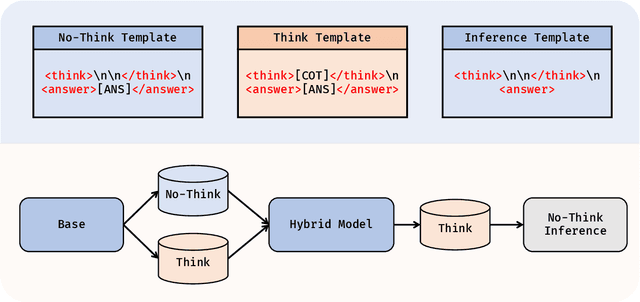
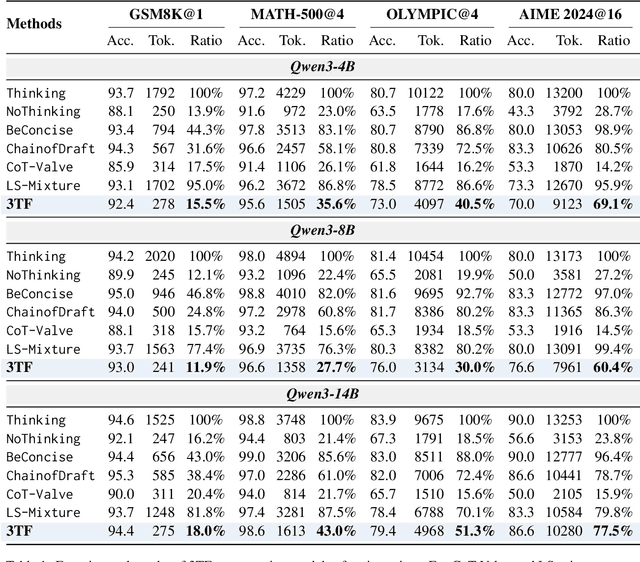

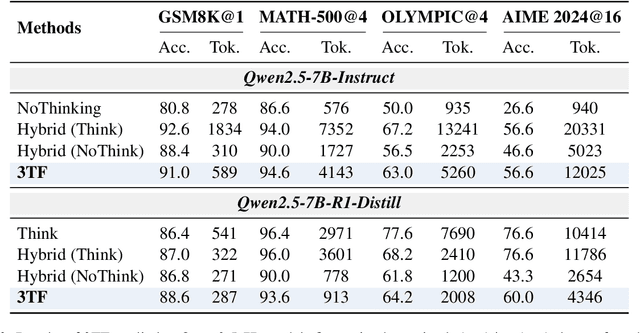
Abstract:Recent advances in large language models (LLMs) have leveraged explicit Chain-of-Thought (CoT) prompting to improve reasoning accuracy. However, most existing methods primarily compress verbose reasoning outputs. These Long-to-Short transformations aim to improve efficiency, but still rely on explicit reasoning during inference. In this work, we introduce \textbf{3TF} (\textbf{T}hought-\textbf{T}raining and \textbf{T}hought-\textbf{F}ree inference), a framework for efficient reasoning that takes a Short-to-Long perspective. We first train a hybrid model that can operate in both reasoning and non-reasoning modes, and then further train it on CoT-annotated data to internalize structured reasoning, while enforcing concise, thought-free outputs at inference time using the no-reasoning mode. Unlike compression-based approaches, 3TF improves the reasoning quality of non-reasoning outputs, enabling models to perform rich internal reasoning implicitly while keeping external outputs short. Empirically, 3TF-trained models obtain large improvements on reasoning benchmarks under thought-free inference, demonstrating that high quality reasoning can be learned and executed implicitly without explicit step-by-step generation.
MotionFlux: Efficient Text-Guided Motion Generation through Rectified Flow Matching and Preference Alignment
Aug 27, 2025
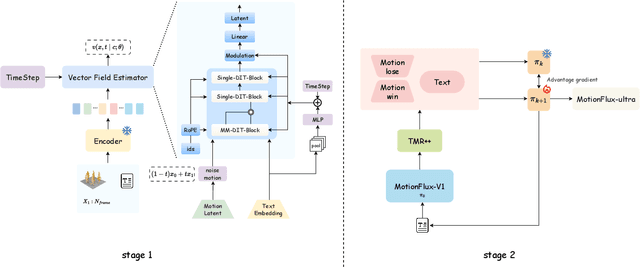
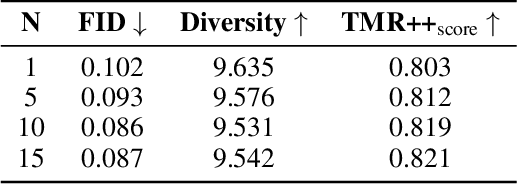
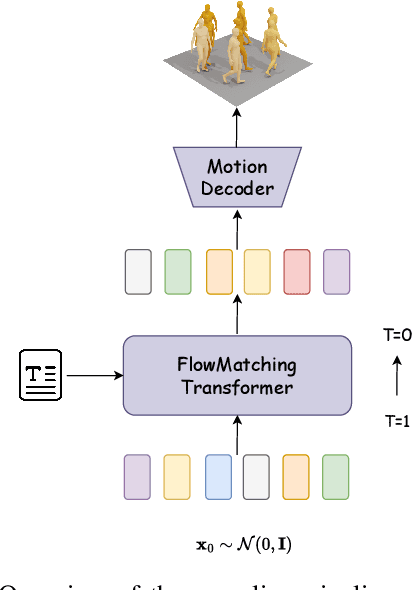
Abstract:Motion generation is essential for animating virtual characters and embodied agents. While recent text-driven methods have made significant strides, they often struggle with achieving precise alignment between linguistic descriptions and motion semantics, as well as with the inefficiencies of slow, multi-step inference. To address these issues, we introduce TMR++ Aligned Preference Optimization (TAPO), an innovative framework that aligns subtle motion variations with textual modifiers and incorporates iterative adjustments to reinforce semantic grounding. To further enable real-time synthesis, we propose MotionFLUX, a high-speed generation framework based on deterministic rectified flow matching. Unlike traditional diffusion models, which require hundreds of denoising steps, MotionFLUX constructs optimal transport paths between noise distributions and motion spaces, facilitating real-time synthesis. The linearized probability paths reduce the need for multi-step sampling typical of sequential methods, significantly accelerating inference time without sacrificing motion quality. Experimental results demonstrate that, together, TAPO and MotionFLUX form a unified system that outperforms state-of-the-art approaches in both semantic consistency and motion quality, while also accelerating generation speed. The code and pretrained models will be released.
ChartMaster: Advancing Chart-to-Code Generation with Real-World Charts and Chart Similarity Reinforcement Learning
Aug 25, 2025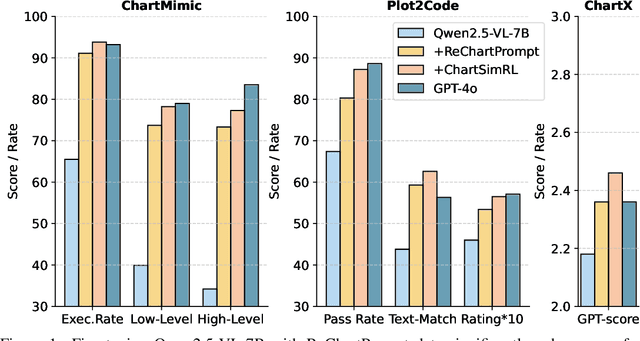

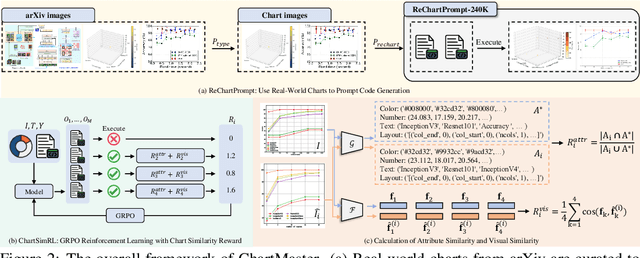

Abstract:The chart-to-code generation task requires MLLMs to convert chart images into executable code. This task faces two major challenges: limited data diversity and insufficient maintenance of visual consistency between generated and original charts during training. Existing datasets mainly rely on seed data to prompt GPT models for code generation, resulting in homogeneous samples. To address this, we propose ReChartPrompt, which leverages real-world, human-designed charts from arXiv papers as prompts instead of synthetic seeds. Using the diverse styles and rich content of arXiv charts, we construct ReChartPrompt-240K, a large-scale and highly diverse dataset. Another challenge is that although SFT effectively improve code understanding, it often fails to ensure that generated charts are visually consistent with the originals. To address this, we propose ChartSimRL, a GRPO-based reinforcement learning algorithm guided by a novel chart similarity reward. This reward consists of attribute similarity, which measures the overlap of chart attributes such as layout and color between the generated and original charts, and visual similarity, which assesses similarity in texture and other overall visual features using convolutional neural networks. Unlike traditional text-based rewards such as accuracy or format rewards, our reward considers the multimodal nature of the chart-to-code task and effectively enhances the model's ability to accurately reproduce charts. By integrating ReChartPrompt and ChartSimRL, we develop the ChartMaster model, which achieves state-of-the-art results among 7B-parameter models and even rivals GPT-4o on various chart-to-code generation benchmarks. All resources are available at https://github.com/WentaoTan/ChartMaster.
Learning Temporal Abstractions via Variational Homomorphisms in Option-Induced Abstract MDPs
Jul 24, 2025

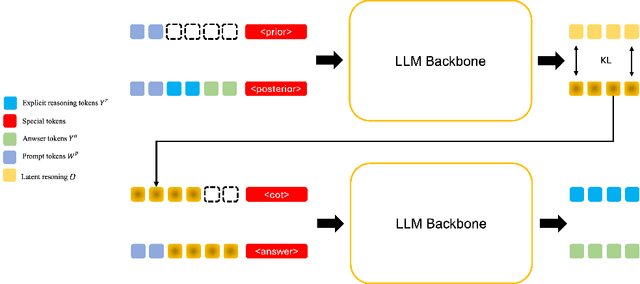

Abstract:Large Language Models (LLMs) have shown remarkable reasoning ability through explicit Chain-of-Thought (CoT) prompting, but generating these step-by-step textual explanations is computationally expensive and slow. To overcome this, we aim to develop a framework for efficient, implicit reasoning, where the model "thinks" in a latent space without generating explicit text for every step. We propose that these latent thoughts can be modeled as temporally-extended abstract actions, or options, within a hierarchical reinforcement learning framework. To effectively learn a diverse library of options as latent embeddings, we first introduce the Variational Markovian Option Critic (VMOC), an off-policy algorithm that uses variational inference within the HiT-MDP framework. To provide a rigorous foundation for using these options as an abstract reasoning space, we extend the theory of continuous MDP homomorphisms. This proves that learning a policy in the simplified, abstract latent space, for which VMOC is suited, preserves the optimality of the solution to the original, complex problem. Finally, we propose a cold-start procedure that leverages supervised fine-tuning (SFT) data to distill human reasoning demonstrations into this latent option space, providing a rich initialization for the model's reasoning capabilities. Extensive experiments demonstrate that our approach achieves strong performance on complex logical reasoning benchmarks and challenging locomotion tasks, validating our framework as a principled method for learning abstract skills for both language and control.
Domain Adaptation from Generated Multi-Weather Images for Unsupervised Maritime Object Classification
Jan 26, 2025



Abstract:The classification and recognition of maritime objects are crucial for enhancing maritime safety, monitoring, and intelligent sea environment prediction. However, existing unsupervised methods for maritime object classification often struggle with the long-tail data distributions in both object categories and weather conditions. In this paper, we construct a dataset named AIMO produced by large-scale generative models with diverse weather conditions and balanced object categories, and collect a dataset named RMO with real-world images where long-tail issue exists. We propose a novel domain adaptation approach that leverages AIMO (source domain) to address the problem of limited labeled data, unbalanced distribution and domain shift in RMO (target domain), and enhance the generalization of source features with the Vision-Language Models such as CLIP. Experimental results shows that the proposed method significantly improves the classification accuracy, particularly for samples within rare object categories and weather conditions. Datasets and codes will be publicly available at https://github.com/honoria0204/AIMO.
Modeling All Response Surfaces in One for Conditional Search Spaces
Jan 08, 2025

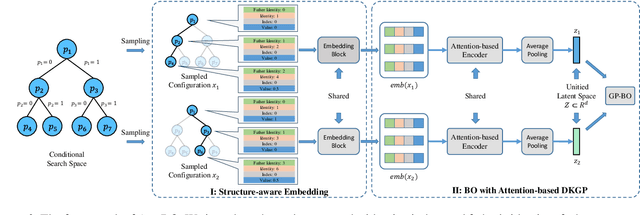
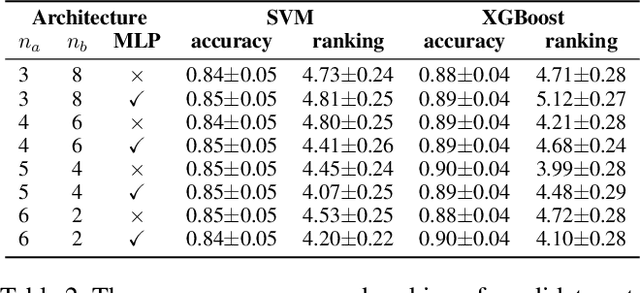
Abstract:Bayesian Optimization (BO) is a sample-efficient black-box optimizer commonly used in search spaces where hyperparameters are independent. However, in many practical AutoML scenarios, there will be dependencies among hyperparameters, forming a conditional search space, which can be partitioned into structurally distinct subspaces. The structure and dimensionality of hyperparameter configurations vary across these subspaces, challenging the application of BO. Some previous BO works have proposed solutions to develop multiple Gaussian Process models in these subspaces. However, these approaches tend to be inefficient as they require a substantial number of observations to guarantee each GP's performance and cannot capture relationships between hyperparameters across different subspaces. To address these issues, this paper proposes a novel approach to model the response surfaces of all subspaces in one, which can model the relationships between hyperparameters elegantly via a self-attention mechanism. Concretely, we design a structure-aware hyperparameter embedding to preserve the structural information. Then, we introduce an attention-based deep feature extractor, capable of projecting configurations with different structures from various subspaces into a unified feature space, where the response surfaces can be formulated using a single standard Gaussian Process. The empirical results on a simulation function, various real-world tasks, and HPO-B benchmark demonstrate that our proposed approach improves the efficacy and efficiency of BO within conditional search spaces.
Beyond Human Data: Aligning Multimodal Large Language Models by Iterative Self-Evolution
Dec 20, 2024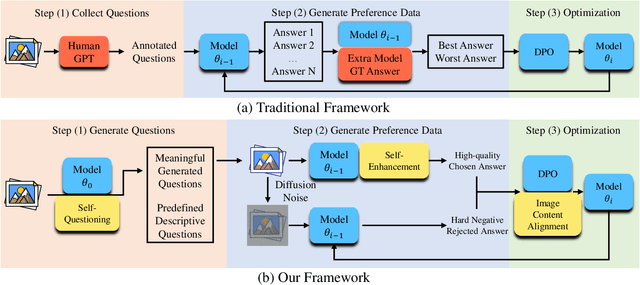



Abstract:Human preference alignment can greatly enhance Multimodal Large Language Models (MLLMs), but collecting high-quality preference data is costly. A promising solution is the self-evolution strategy, where models are iteratively trained on data they generate. However, current techniques still rely on human- or GPT-annotated data and sometimes require additional models or ground truth answers. To address these issues, we propose a novel multimodal self-evolution framework that enables the model to autonomously generate high-quality questions and answers using only unannotated images. First, we implement an image-driven self-questioning mechanism, allowing the model to create and evaluate questions based on image content, regenerating them if they are irrelevant or unanswerable. This sets a strong foundation for answer generation. Second, we introduce an answer self-enhancement technique, starting with image captioning to improve answer quality. We also use corrupted images to generate rejected answers, forming distinct preference pairs for optimization. Finally, we incorporate an image content alignment loss function alongside Direct Preference Optimization (DPO) loss to reduce hallucinations, ensuring the model focuses on image content. Experiments show that our framework performs competitively with methods using external information, offering a more efficient and scalable approach to MLLMs.
Simultaneous Computation and Memory Efficient Zeroth-Order Optimizer for Fine-Tuning Large Language Models
Oct 13, 2024
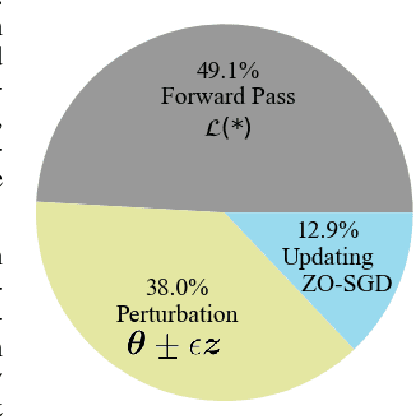
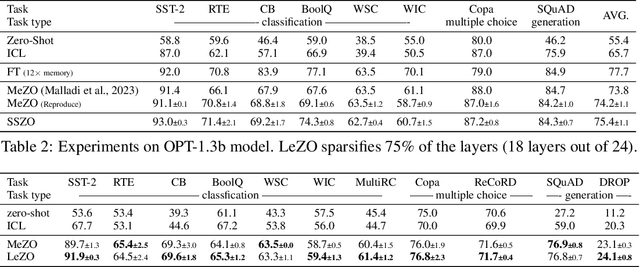
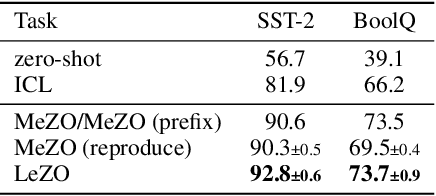
Abstract:Fine-tuning is powerful for adapting large language models to downstream tasks, but it often results in huge memory usages. A promising approach to mitigate this is using Zeroth-Order (ZO) optimization, which estimates gradients to replace First-Order (FO) gradient calculations, albeit with longer training time due to its stochastic nature. By revisiting the Memory-efficient ZO (MeZO) optimizer, we discover that the full-parameter perturbation and updating processes consume over 50% of its overall fine-tuning time cost. Based on these observations, we introduce a novel layer-wise sparse computation and memory efficient ZO optimizer, named LeZO. LeZO treats layers as fundamental units for sparsification and dynamically perturbs different parameter subsets in each step to achieve full-parameter fine-tuning. LeZO incorporates layer-wise parameter sparsity in the process of simultaneous perturbation stochastic approximation (SPSA) and ZO stochastic gradient descent (ZO-SGD). It achieves accelerated computation during perturbation and updating processes without additional memory overhead. We conduct extensive experiments with the OPT model family on the SuperGLUE benchmark and two generative tasks. The experiments show that LeZO accelerates training without compromising the performance of ZO optimization. Specifically, it achieves over 3x speedup compared to MeZO on the SST-2, BoolQ, and Copa tasks.
Question Calibration and Multi-Hop Modeling for Temporal Question Answering
Feb 20, 2024



Abstract:Many models that leverage knowledge graphs (KGs) have recently demonstrated remarkable success in question answering (QA) tasks. In the real world, many facts contained in KGs are time-constrained thus temporal KGQA has received increasing attention. Despite the fruitful efforts of previous models in temporal KGQA, they still have several limitations. (I) They adopt pre-trained language models (PLMs) to obtain question representations, while PLMs tend to focus on entity information and ignore entity transfer caused by temporal constraints, and finally fail to learn specific temporal representations of entities. (II) They neither emphasize the graph structure between entities nor explicitly model the multi-hop relationship in the graph, which will make it difficult to solve complex multi-hop question answering. To alleviate this problem, we propose a novel Question Calibration and Multi-Hop Modeling (QC-MHM) approach. Specifically, We first calibrate the question representation by fusing the question and the time-constrained concepts in KG. Then, we construct the GNN layer to complete multi-hop message passing. Finally, the question representation is combined with the embedding output by the GNN to generate the final prediction. Empirical results verify that the proposed model achieves better performance than the state-of-the-art models in the benchmark dataset. Notably, the Hits@1 and Hits@10 results of QC-MHM on the CronQuestions dataset's complex questions are absolutely improved by 5.1% and 1.2% compared to the best-performing baseline. Moreover, QC-MHM can generate interpretable and trustworthy predictions.
Poisson Process for Bayesian Optimization
Feb 05, 2024



Abstract:BayesianOptimization(BO) is a sample-efficient black-box optimizer, and extensive methods have been proposed to build the absolute function response of the black-box function through a probabilistic surrogate model, including Tree-structured Parzen Estimator (TPE), random forest (SMAC), and Gaussian process (GP). However, few methods have been explored to estimate the relative rankings of candidates, which can be more robust to noise and have better practicality than absolute function responses, especially when the function responses are intractable but preferences can be acquired. To this end, we propose a novel ranking-based surrogate model based on the Poisson process and introduce an efficient BO framework, namely Poisson Process Bayesian Optimization (PoPBO). Two tailored acquisition functions are further derived from classic LCB and EI to accommodate it. Compared to the classic GP-BO method, our PoPBO has lower computation costs and better robustness to noise, which is verified by abundant experiments. The results on both simulated and real-world benchmarks, including hyperparameter optimization (HPO) and neural architecture search (NAS), show the effectiveness of PoPBO.
 Add to Chrome
Add to Chrome Add to Firefox
Add to Firefox Add to Edge
Add to Edge